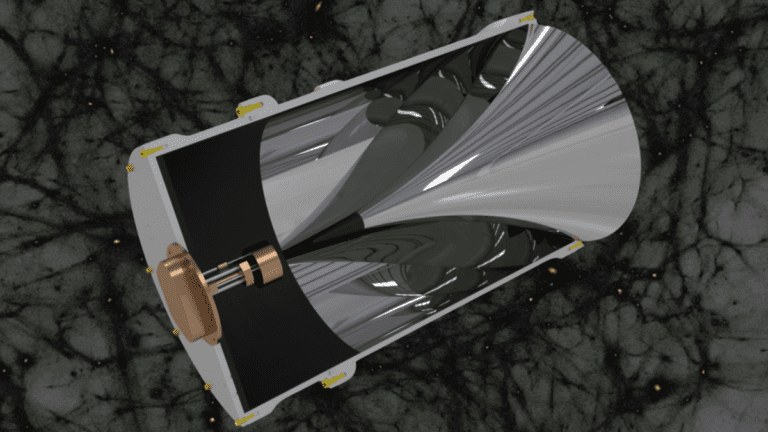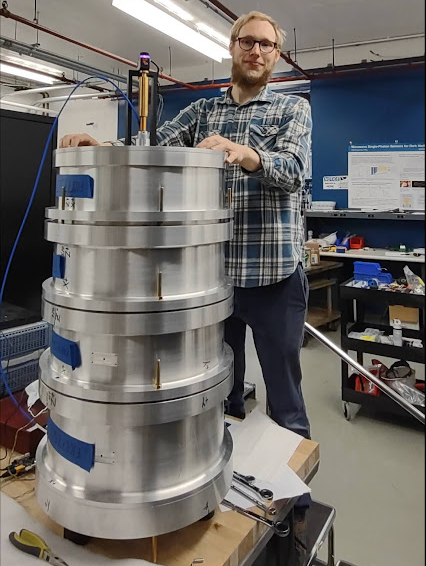
[ad_1]
A new experiment designed to search the cosmos for its most mysterious “stuff,” dark matter, has delivered its first results.
While the Broadband Reflector Experiment for Axion Detection (BREAD) developed by the University of Chicago and the U.S. Department of Energy’s Fermilab hasn’t turned up dark matter particles just yet, the new results place a tighter constraint on the type of characteristics scientists can expect such particles to have. The BREAD experiment itself also served up an exciting new recipe that could be used in the hunt for dark matter — a relatively inexpensive one that doesn’t take up a vast amount of space.
BREAD takes a “broadband” approach to search for hypothetical dark matter particles called “axions” and associated “dark photons” across a larger set of possibilities than other experiments, albeit with slightly less precision.
“If you think about it like a radio, the search for dark matter is like tuning the dial to search for one particular radio station, except there are a million frequencies to check through,” University of Chicago scientist and BREAD project co-leader David Miller said in a statement. “Our method is like doing a scan of 100,000 radio stations, rather than a few very thoroughly.”
Related: What is dark matter?
A small experiment to tackle a big problem
Dark matter represents a huge problem for scientists because, despite the fact it makes up around 85% of the matter in the universe and its influence prevents galaxies from flying apart as they spin, we have little idea what it is made of.
That is in part because dark matter is effectively invisible; it doesn’t seem to interact with light, neither emitting nor reflecting standard photons. That lack of electromagnetic interaction suggests that dark matter isn’t composed of the protons, neutrons and electrons that comprise “normal matter” objects like stars, planets, moons, our bodies and the cat next door.
Though our telescopes can’t detect dark matter directly, the stuff does affect stars, galaxies, and even light via its interactions with gravity. So astronomers can tell that something is there — they just don’t know what it is. Knowing what to look for and exactly where to look is a different matter.
“We’re very confident that something is there, but there are many, many forms it could take,” said Miller.
This confusion has sent scientists on the hunt for different particles with strange properties that could comprise dark matter. One such candidate is the axion, a hypothetical particle with an extremely small mass. Should axions exist, they may interact with a so-called dark photon just as everyday matter interacts with “ordinary” photons. This interaction could occasionally prompt the creation of a visible photon under certain circumstances.

BREAD is a coaxial dish antenna in the shape of a curved metal tube that can fit on a tabletop. The experiment is designed to catch photons and funnel them to a sensor at one end to search for a subset of possible axions.
The full-scale BREAD experiment will see the equipment sit within a strong magnetic field, which the team says will increase the chances of the conversion of axons to photons. As a proof of principle, the team conducted a BREAD experiment minus the magnets needed to generate this field.
The proto-BREAD experiment ran at the University of Chicago for a month and delivered some interesting data, whetting the team’s appetite for the full-scale experiment. The test results showed that BREAD was highly sensitive in the range of frequencies that the team had designed it to probe.
“This is just the first step in a series of exciting experiments we are planning,” BREAD co-leader and Fermilab researcher Andrew Sonnenschein said. “We have many ideas for improving the sensitivity of our axion search.”
The test also demonstrated that particle physics can be done on a tabletop as well as in huge particle accelerators like the Large Hadron Collider (LHC), which runs for 17 miles (27 kilometers) deep under the border between France and Switzerland.
“This result is a milestone for our concept, demonstrating for the first time the power of our approach,” said Stefan Knirck, the Fermilab postdoctoral scholar who led the development and construction of BREAD. “It is great to do this kind of creative tabletop-scale science, where a small team can do everything from building the experiment to data analysis but still have a great impact on modern particle physics.”
The next stage of the BREAD experiment will see the apparatus transported to the magnet facility at Argonne National Laboratory. Additionally, facilities like SLAC National Accelerator Laboratory, MIT, Caltech, and NASA’s Jet Propulsion Laboratory are working on research and development with the University of Chicago and Fermilab for future recipes of the BREAD experiment.
“There are still so many open questions in science and an enormous space for creative new ideas for tackling those questions,” Miller concluded. “I think this is a real hallmark example of those kinds of creative ideas — in this case, impactful, collaborative partnerships between smaller-scale science at universities and larger-scale science at national laboratories.”
The team’s research is detailed in a paper published late last month in the journal Physical Review Letters.
[ad_2]